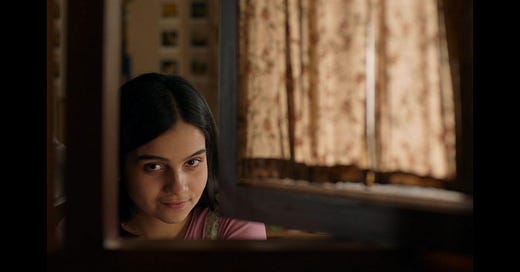Vencedor do Prêmio Especial do Júri de Melhor Atriz e Prêmio do Público de Melhor Filme no Festival de Sundance 2024, Sempre Garotas é um cinema que atua como janela aberta para uma realidade que nossos olhares não alcançam. Quando enfim o fazem, aí o cinema pode se transformar na “máquina de empatia”, denominação criada por Roger Ebert para se referir ao poder da arte cinematográfica de nos situar na perspectiva dos personagens. Este filme escrito e dirigido por Shuchi Talati debate temas universais: o amadurecimento feminino, o desejo e a sexualidade, a relação mãe e filha, mas a partir do olhar indiano de Mira (Preeti Panigrahi), a aluna referência de uma escola local. Ela se envolve com o recém chegado Sri (Kesav Binoy Kiron), um romance adolescente que não imporia nenhum conflito dramático que seja dentro do olhar ocidental, embora na realidade que Mira está, signifique bastante.
“Tomem cuidado com os meninos”, é o conselho dado pela diretora às alunas que poderia ser dado em qualquer parte do mundo, mas não da mesma forma que a narrativa: Mira e a sua melhor amiga são comparadas pelo comprimento da saia que estão vestindo. A de Mira, exemplar, está abaixo do joelho, protegendo-a do comportamento abusivo dos alunos que fotografam as calcinhas das alunas. A culpa é das saias, ou da educação dos jovens? Contudo, Mira é parte dessa estrutura - possuir as chaves da instituição é uma forma de inseri-la, nem que temporariamente -, cobrando de uma aluna as meias certas e, da melhor amiga, as unhas pintadas. Evidente que essa tarefa de ‘policiar’ os colegas vá causar atritos e conflitos, dentro de uma metonímia do que é a sociedade indiana, à qual Mira está preparada a integrar.
A princípio, o romance, depois, a relação com a mãe, são as chaves de Mira para não se submeter a desígnios de quem só vislumbra a vida acadêmica como o objetivo solo, e o romance é abordado com uma ingenuidade cativante: primeiro, a ênfase nas mãos e no toque; em seguida, do encontro concluído com um beijo no rosto. Ainda que Mira seja só uma adolescente, e adolescentes onde quer que tenham nascido sentam o desejo do outro, no ambiente conservador onde está, a manifestação é praticamente uma atitude revolucionária. É o meio que força Mira a correr depois do beijo, ou a encontrar-se em um espaço secreto, ou no interior de casa, alcovitada pela mãe Anila (Kani Kusruti, de Tudo Que Imaginamos Como Luz), pois na verdade todo jovem na experimentou beijar a mão para não desapontar no primeiro beijo.
O desejo de Mira está na masturbação com o bichinho de pelúcia ou na depilação para poder utilizar a saia acima do joelho. Isso a universaliza, dentro de uma cultura ímpar. É aí que opera a máquina de empatia, na percepção de que pessoas têm desejos comuns embora estes costumam ser constrangidos ou reprimidos por sociedades diversas. Até há uma discussão sobre a influência ocidental no comportamento individual: Sri é um estudante de uma escola internacional, que trouxe, consigo, a bagagem da pluralidade cultural. A participação em um clube de astronomia revela a aspiração para o ‘mundo’ além do nosso, para a realidade que não a que lhe é dada. Este tema é complexificado a partir de elementos diegéticos: a canção que Anila dança é de Rod Stewart; já seu livro de cabeceira é reprovado pela filha (quando incorpora em si uma estrutura opressora). E também é complexificado na forma.
A narrativa emprega a direção de arte de Avyakta Kapur para criar quadros dentro de quadros, em que os personagens espiam outros personagens de cômodos diferentes, e esta separação é evidenciada pela limitação espacial. É como se houvesse um conjunto de camadas de controle e exclusão: Mira tem o comportamento vigiado pela mãe - por motivos que discuto à frente -, enquanto começa a se sentir excluída dentro do próprio lar, espiando a relação entre Anila e Sri que não compreende exatamente… nem nós. A sensação é de que Anila, cujo casamento é pautado pela ausência, enxerga em Sri uma porta para voltar a sentir desejo. É uma leitura possível, considerado as provocações e os indícios deixados na narrativa (I wanna show you the real me - ou Eu quero mostrar-lhe o meu verdadeiro eu - é um refrão exclamativo cantado por Anila). Uma leitura que não é exatamente excludente de sua preocupação com o desempenho acadêmico da filha, e do amor que sente por ela.
A partir da maneira intimista com que a direção de fotografia de Jih-E Peng explora a vida de Mira, enquadrando-a em uma razão de aspecto quadrada, e conferindo-lhe um mundo de emoções somente a partir da proximidade da câmera e de onde a posiciona na imagem. Mira pode ocupar o centro da imagem, ou pode estar no canto esquerdo e inferiorizada ao tratar com a melhor amiga; ou ela pode manter a postura dominante e altiva de aluna exemplar, ou estar distante, praticamente no fundo da imagem, embora perto para que sintamos a mágoa e frustração da talentosa Preeti Panigrahi. De forma análoga como sentimentos a relação de Mira e Sri desenvolver-se a partir do diálogo e dissidência dos figurinos: a complementariedade que há entre o amarelo que ela veste e o azul dele é um exemplo.
Em tudo isso, há a imagem marcante de uma jovem, igual a qualquer jovem no mundo inteiro, que amadurece, experimenta o amor e a dor consequente, vivencia alegrias ou traumas, deseja, sente, e chora. Que bonito é Sempre Garotas!
Girls will be Girls, english review
Winner of the Special Jury Prize for Best Actress and the Audience Award for Best Film at the 2024 Sundance Film Festival, Girls Will Be Girls is a film that acts as an open window to a reality that our eyes cannot see. When they finally do, cinema can become an “empathy machine,” a term coined by Roger Ebert to refer to the power of cinematographic art to place us in the perspective of the characters. This film, written and directed by Shuchi Talati, discusses universal themes: female coming of age, desire and sexuality, and the mother-daughter relationship, but from the Indian perspective of Mira (Preeti Panigrahi), the top student at a local school. She becomes involved with the newly arrived Sri (Kesav Binoy Kiron), a teenage romance that would not impose any dramatic conflict within the Western perspective, although in the reality that Mira is in, it means a lot.
“Be careful with the boys,” is the advice given by the principal to the students, which could be given anywhere in the world, but not in the same way as the narrative: Mira and her best friend are compared by the length of the skirt they are wearing. Mira’s, exemplary, is below the knee, protecting her from the abusive behavior of the students who photograph the students’ panties. Is it the skirts’ fault, or the education of the young male? However, Mira is part of this structure - having the keys to the institution is a way of inserting her, even if temporarily -, demanding that a student wear the right socks and that her best friend undo her painted nails. It is clear that this task of ‘policing’ her classmates will cause friction and conflict, within a metonymy of what Indian society is, to which Mira is prepared to integrate.
At first, romance, then her relationship with her mother, are Mira's keys to not submitting to the designs of those who only see academic life as their sole objective, and romance is approached with captivating naivety: first, the emphasis on hands and touch; then, the encounter concluded with a kiss on the cheek. Even though Mira is just a teenager, and teenagers wherever they are born feel the desire for each other, in the conservative environment in which she lives, the manifestation is practically a revolutionary attitude. It is the environment that forces Mira to run after the kiss, or to meet in a secret space, or inside the house, pimped out by her mother Anila (Kani Kusruti, from All We Imagine as Light), because in truth every young person has not tried kissing a hand so as not to disappoint on the first kiss.
Mira's desire manifests in hers masturbation with a stuffed animal or after shaving so she can wear a skirt above the knee. This universalizes her, within a unique culture. This is where the empathy machine operates, in the perception that people have common desires, although these are often constrained or repressed by different societies. There is even a discussion about Western influence on individual behavior: Sri is a student at an international school, who brought with him the baggage of cultural plurality. His participation in an astronomy club reveals his aspiration for the ‘world’ beyond ours, for a reality other than the one he is given. This theme is complicated by diegetic elements: the song Anila dances to is by Rod Stewart; her bedside book is disapproved by her daughter (because it incorporates an oppressive structure). And it is also complicated in form.
The narrative uses Avyakta Kapur’s art direction to create frames within frames, in which characters spy on other characters from different rooms, and this separation is evidenced by spatial limitations. It is as if there were a set of layers of control and exclusion: Mira's behavior is monitored by her mother - for reasons that I will discuss later -, while she begins to feel excluded within her own home, spying on the relationship between Anila and Sri that she does not exactly understand... nor do we. The feeling is that Anila, whose marriage is based on absence, sees in Sri a door to feeling desire again. This is a possible reading, considering the provocations and clues left in the narrative (I wanna show you the real me is an exclamatory refrain sung by Anila). A reading that does not exactly exclude her concern for her daughter's academic performance, and the love she feels for her.
Starting from the intimate way in which Jih-E Peng's cinematography explores Mira's life, framing her in a square aspect ratio, and giving her a world of emotions only from the proximity of the camera and where it is positioned in the image. Mira can occupy the center of the image, or she can be in the left corner and belittled when dealing with her best friend; or she can maintain the dominant and haughty posture of an exemplary student, or be distant, practically in the background of the image, although close enough for us to feel the hurt and frustration of the talented Preeti Panigrahi. In a similar way, Mira's relationship with Sri develops from the dialogue and dissent of the costumes: the complementarity between the yellow she wears and his blue is an example.
In all this, there is the striking image of a young woman, just like any young woman in the whole world, who matures, experiences love and the consequent pain, experiences joy or trauma, desires, feels, and cries. How beautiful this movie is!








